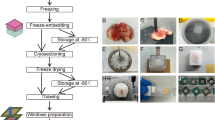Summary
Chondrocytes in epiphyseal cartilage were examined by scanning electron microscopy (SEM) and transmission electron microscopy (TEM) using freeze-fracture techniques. Freeze-fracture replicas showed large numbers of fingerlike, 0.11–0.15 μm diameter, projections from the chondrocyte surface, with numerous 95–180 Å diameter intramembranous particles associated with both the cell membrane surface and these projections. With SEM, these cytoplasmic projections were also obvious, but appeared collapsed into clusters of globular-shaped projections on the surface of the chondrocytes. With freeze-fracture techniques, in which shrinkage artifacts were essentially eliminated, the cytoplasmic projections were often seen in intimate contact with the extracapsular matrix. However, with chondrocytes prepared by both SEM and conventional TEM, there was evidence of shrinkage, the cytoplasmic projections having little contact with the extracapsular matrix. These findings show that the cytoplasmic processes are not artifacts of tissue processing and provide morphological evidence in support of the hypothesis that matrix vesicles are of cellular origin.
Similar content being viewed by others
References
Anderson, H.C.: Vesicles associated with calcification in the matrix of epiphyseal cartilage, J. Cell Biol.41:59–72, 1969
Bonucci, E.: Fine structure and histochemistry of “calcifying globules” in epiphyseal cartilage, Z. Zellforsch. Mikrosk. Anat.103:192–217, 1970
Holtrop, M.E.: The ultrastructure of the epiphyseal plate. II. The hypertropic chondrocyte, Calcif. Tissue Res.9:140–151, 1972
Zimny, M.L., Redler, I.: Scanning electron microscopy of chondrocytes, Acta Anat. (Basel)83:398–402, 1972
Lufti, A.M.: The ultrastructure of cartilage cells in the epiphyseal plate of long bones in the domestic fowl, Acta Anta. (Basel)87:12–21, 1974
Bozdech, A., Horn, V.: The morphology of growth cartilage using the scanning electron microscope, Acta Orthop. Scand.46:561–568, 1975
Savostin-Asling, I., Asling, C.E.: Transmission and scanning electron microscope studies of calcified cartilage resorption. Anat. Rec.,193:373–391, 1975
Clarke, I.C.: Articular cartilage: A review and scanning electron microscope study. II. The territorial fibrillar architecture, J. Anat.117:261–280, 1974
Rabinovitch, A.L., Anderson, H.C.: Biogenesis of matrix vesicles in cartilage growth plates, Fed. Proc.35:112–116, 1976
Spycher, M.A., Moor, H., Ruettner, J.E.: Electron microscopic investigations on ageing and osteoarthrotic human articular cartilage. II. The fine structures of freeze-etched ageing hip joint cartilage, Z. Zellforsch. Microsk. Anat.98:512–524, 1969
Wuthier, R.E., Majeska, R.J., Collins, G.M.: Biosynthesis of matrix vesicles in epiphyseal cartilage. I. In vivo incorporation of32P-orthophosphate into phospholipids of chondrocytes membrane, and matrix vesicle fractions, Calcif. Tissue Res.23:135–139, 1977
Author information
Authors and Affiliations
Additional information
Correlation of Freeze-Fracture and Scanning Electron Microscopy of Epiphyseal Chondrocytes
Rights and permissions
About this article
Cite this article
Borg, T.K., Runyan, R.B. & Wuthier, R.E. Correlation of freeze-fracture and scanning electron microscopy of epiphyseal chondrocytes. Calc. Tis Res. 26, 237–241 (1978). https://doi.org/10.1007/BF02013264
Received:
Revised:
Accepted:
Issue Date:
DOI: https://doi.org/10.1007/BF02013264




